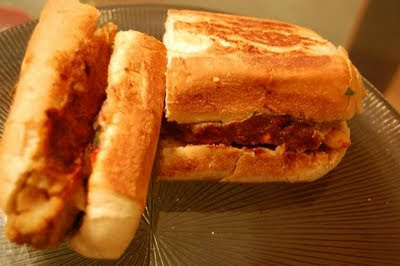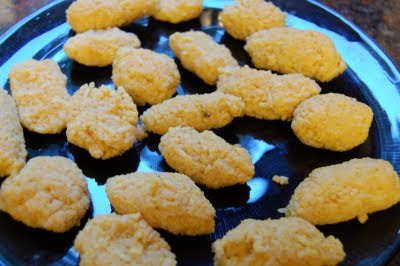My 50th Post!!!!
Since it is my 50th post, I thought I would post about a dish that I really love, and can have anytime anywhere :)
Pani Puri or Gol Gappa is a very famous chaat eaten all over India. Crispy hollow semolina balls (puri), filled with potato and mung mixture, sweet and tangy dates and tamarind chutney, hot ragda mixture (you get this in Bombay) and very spicy chilled water…its just ummmm!!!! This is my most favorite chaat.
Sometimes its hard to find the puris here in the US, so I have given recipe for the puris too. But if you do get at the India stores near you, just buy the ready made puris; this will save a lot of cooking time.
Here are the ingredients:
Puri(s): This will make about 35-40
1/2 Cup Very Fine Semolina (Very Fine Rava)
1/8th Cup Whole Wheat Flour
Salt to taste
Stuffing:
2 Medium Potatoes, boiled and cut into small pieces
1/4th Cup Mung beans, Soaked Overnight
(Optional):1/4th Cup Dried White Peas (ragda ka chana), Soaked Overnight
Chat masala to taste
Salt to taste
1/4th Teaspoon Turmeric powder
Khajur Imli Chutney (
Sweet and Sour Chutney): Click
here for the recipe.
Pani (Spicy Water):
1 Cup Fresh Mint Leaves (Phudina)
3-4 Green Chilies (or to taste)
1/4th Teaspoon Black Pepper Powder
1 Teaspoon Black Salt/Rock Salt (Sanchad/Sindhav Namak)
6 Teaspoon Lemon Juice
¼ Teaspoon Ginger Powder
1/2 Teaspoon Salt
1 Teaspoon Sugar
1/8th Teaspoon Asafoetida
1/8th Cup Cilantro, Optional
1/4th Cup salted Bundi, (an Indian Snack), Optional-For Garnishing
6 Cups Water
Method:
Pani (Spicy Water): I am giving the method of making pani first because; pani is usually made a day in advance. This way the flavors will blend overnight, and give it a unique tangy-spicy taste. Combine all the ingredients except the water. Grind to a very fine and smooth paste. Add some water while grinding if needed. Strain this paste with the help of a muslin cloth. Add 6 cups water to the strained paste. Now tie the muslin cloth so that the leftover mixture doesn’t come out. Drop the cloth in the water. Stir once and taste for salt or lemon. Add more salt or lemon juice if needed (per your taste).
Don't add any chili unless you don't taste any chili at all. The water will get chili flavor overnight while the muslin cloth is dipped in the water.
If you don't have a muslin cloth, you can skip the straining step and add 6 cups of water directly to the paste. Let it sit overnight. The next day, strain it with fine mesh (tea strainer) before serving. If you have bundi, add it to the water a few minutes before serving.
For Puris:
Combine the two flours and salt together. Add a little water at a time and need dough out of it. Cover with a bowl or a wet cloth and let it sit for 25-30 minutes.
After 30 minutes, heat oil in a deep frying pan, kneed the flour once more, and roll into 1 to 1-1/2inch (max) thin rounds. Alternatively, you can roll a big 6-7 inch round and cut small rounds out of it with the help of a small lid of a narrow mouth jar (this saves some time). Make sure that the lid is no more than 1-1/2inch in diameter, as it will make big puris, which will be hard to put in your mouth without breaking:).
It is a little tricky to get set the oil temperature to get each puris perfectly puffed up. With my trials and errors, I have found that I can set my stove temperature at 4, with 1 being simmer and 10 being high, I get very well puffed (and not burnt) puris in each batch.
This is how I fry my puris: In the beginning, I set the oil temperature to High (10), once the oil temperature has reached (6-7 minutes); I turn it down to medium-low (4). Wait for 4-5 minutes, and then add one puri. As soon as it comes up, very lightly press with the frying spoon to get it puffed up. Once the puri has puffed up, turn it to the other side immediately, and add another puri. Fry on both sides to get golden brown color. Remove from the tava and let it drain on an absorbent paper. I fry 5-6 puris in one batch. You can change the quantity depending on the size of your frying pan (tava).
Some people fry all the puris at once, and cover them with a wet cloth. From my experience, I have found that its better to fry fresh puris (to get them puffed up) rather then rolling it all at once and covering them with wet cloth, but you can try either method. If you want to roll all the puris at once, and then make sure you cover them with wet cloth, and not let them dry out. If you want to roll fresh puris, then roll 8-10 at a time and put them in the hot oil. While they are frying you can roll the next batch.
The puris can be made in advance. For storing it, let it cool down completely and store in an airtight container. It should last atleast for 2-3 months.
The picture above shows my homemade puris:)
For the Stuffing:
Drain the mung beans and save water. Heat a tava (pan); add 1 teaspoon oil (optional). Once the oil/tava is hot, add the mung beans, salt, 1/4th teaspoon turmeric powder and very little water. Turn the flame to low and cook covered. Keep checking the water, and as little at a time when needed. We want the mungs to be cooked in such a way that each grain should be separate at the end, so low temperature is necessary for cooking. Don’t make it soggy by adding a lot of water at once.
If you want to make the ragda, then while the mungs are getting cooked, pressure cook the white peas with salt and 1/4th teaspoon turmeric powder in 1 cup water. Also, put 4-5 dates (for chutney) in a separate dish in the pressure cooker. Pressure cook for 4-5 whistles.
If you don’t want to make the ragda, then just boil the dates in enough water instead of pressure cooking. When the peas are cooked, take out, add some water if its too dry and cook for 3-4 minutes. Keep aside.
In the boiled and cut potatoes, add salt and chaat masala to taste; mix well and set aside.
Serving:
I don’t think I need to explain any Indian about the serving method, but for those of you who don’t know, here is how to eat Pani Puri. Carefully tap/crack the thin layer side of the puri to make a hole in this layer. Stuff a few pieces of potatoes and about 1/2 teaspoon mung through this hole. Add 1/2 teaspoon hot ragda mixture. Then add the sweet chutney per your taste. Now dip the puri in the pani (spicy water) OR add some pani to the puri and put the whole puri in your mouth!!! :) Enjoy.
Note: Adjust the amount of stuffing in puri per your taste.
Thank you for visiting Food Garden and Fun. I would love to hear from you. I appreciate your time to leave feedback and help me improve this blog.





































